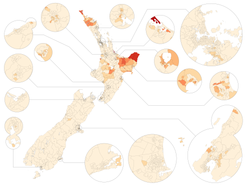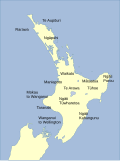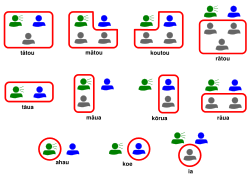Māori language
The Māori language (Māori: [Te Reo Māori] Error: {{Lang}}: text has italic markup (help), shortened to Te Reo) is the language of the Māori and an official language of New Zealand. It is an Austronesian language.
| Māori | ||||
|---|---|---|---|---|
| Māori | ||||
| Native to | New Zealand | |||
| Region | Polynesia | |||
| Ethnicity | Māori people | |||
| Native speakers | (60,000 cited 1991) 157,000 New Zealand residents claim they can converse in Māori about everyday things (2006 census)[1] | |||
| Language family | ||||
| Writing system | Latin (Māori alphabet) Māori Braille | |||
| Official status | ||||
| Official language in | New Zealand | |||
| Regulated by | Māori Language Commission | |||
| Language codes | ||||
| ISO 639-1 | mi | |||
| ISO 639-2 | mao (B) mri (T) | |||
| ISO 639-3 | mri | |||
| ||||
| This language has its own Wikipedia project. See the Māori language edition. |
Although it is an official language, not many people speak it fluently. In the 2013 census, about 149,000 people, (3.7% of the population) said that they could have a conversation in Māori about a lot of everyday things.
The language can be seen everywhere throughout New Zealand, as many of the placenames are Māori, such as Whangarei, Rotorua, and Timaru. Lots of government or city buildings use te reo on their signs as well as English, and most of the public schools have a Māori name as well as an English one.[2][3] Some Māori people living in Australia also speak the language.
Te Reo Māori did not have a writing system until the Europeans arrived. In 1817, a Ngāpuhi chief, Tītori, and his relative Tui worked with Professor Samuel Lee and prepared a writing system for te reo.
Māori Language Media
"First Lessons in the Maori Language", 1862,by W. L. Williams, third Bishop of Waiapu
Bastion Point land rights activists with Māori-language signs
Bilingual sign in Broadwood, Northland
North Island dialects[4]
Diagram of pronouns in Māori. Grammatical person: Template:Hlist*
References
- ↑ Statistics New Zealand:Language spoken (total responses) for the 1996–2006 censuses (Table 16) Archived 2013-03-09 at Archive-It.
- ↑ "Newtown School | Wellington". Retrieved 27 January 2020.
- ↑ "Wellington High School". Wellington High School. Retrieved 27 January 2020.
- ↑ Harlow 2007.







